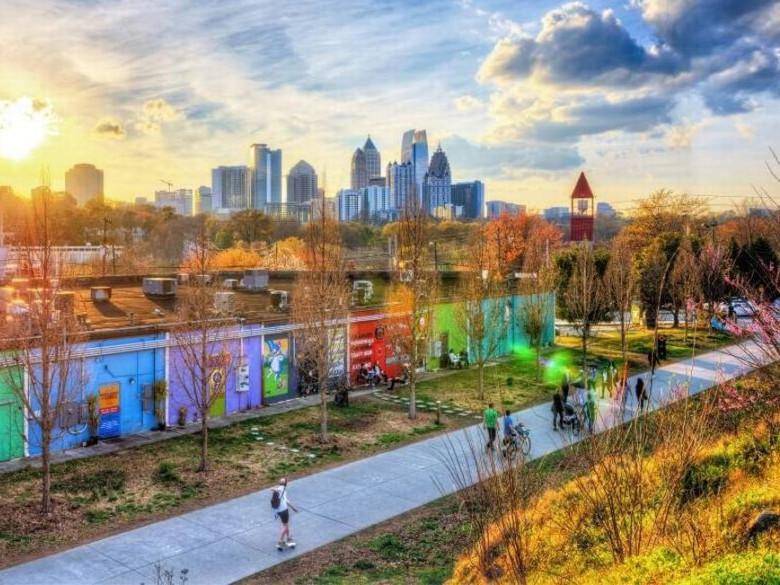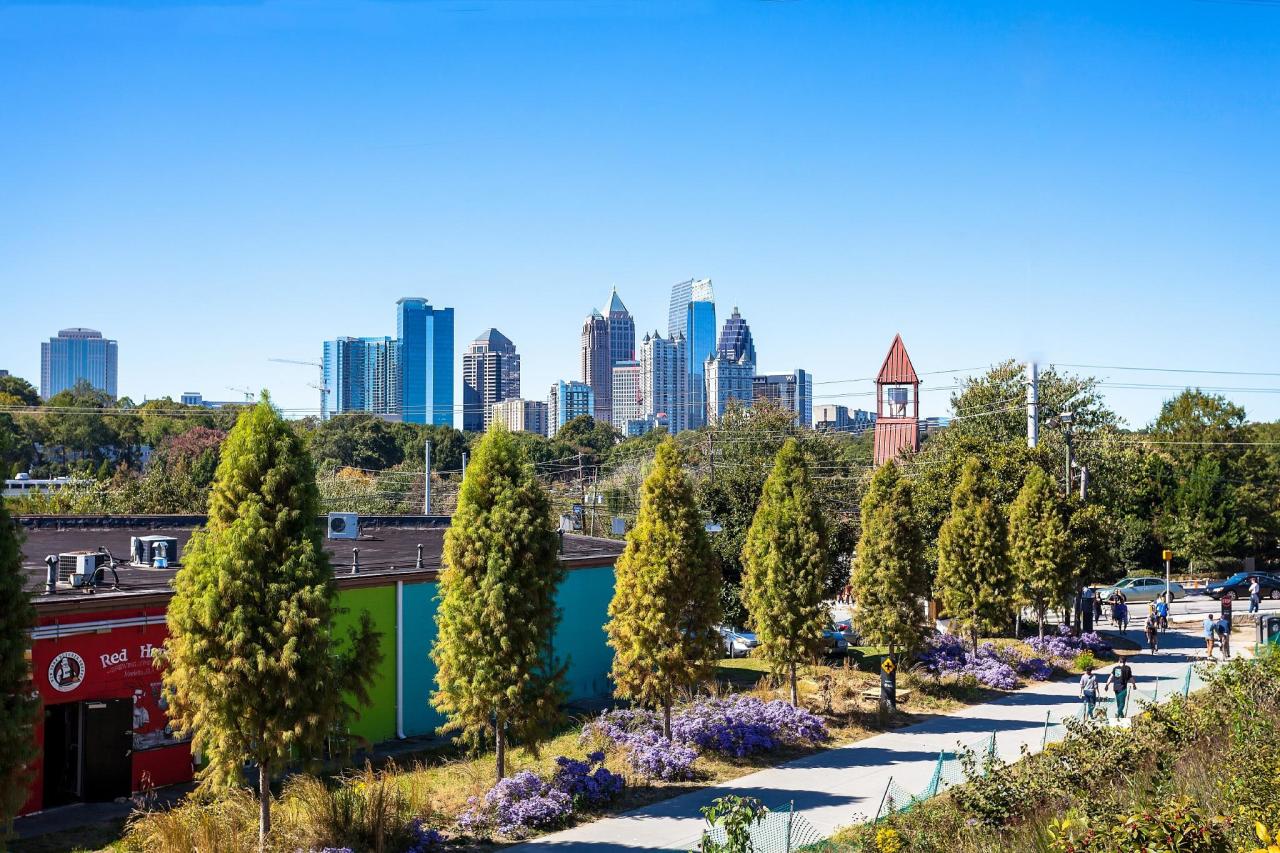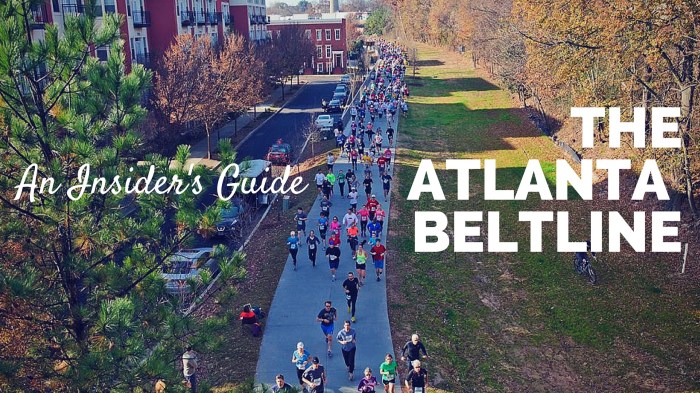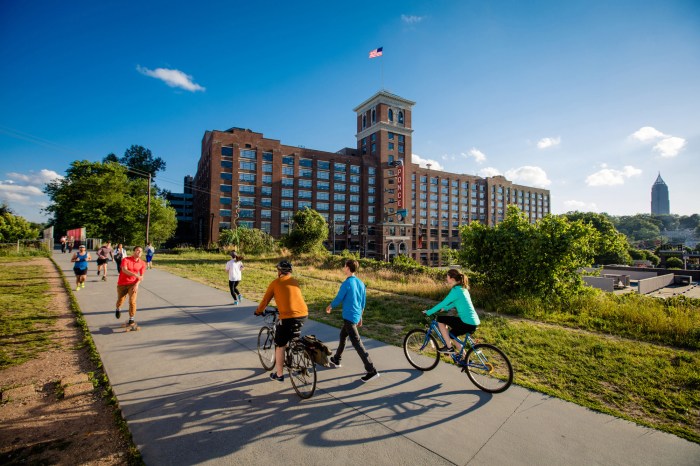The Atlanta BeltLine, a transformative urban renewal project, is redefining the city’s landscape and shaping its future. Envisioned as a 22-mile loop of trails, parks, and transit, the BeltLine is connecting neighborhoods, fostering economic development, and enhancing the city’s overall well-being.
From its inception to its ongoing expansion, the BeltLine’s impact has been profound. It has revitalized neglected areas, created vibrant public spaces, and stimulated job growth. As the project continues to evolve, it promises to further enhance Atlanta’s livability and sustainability.
Atlanta BeltLine Overview
The Atlanta BeltLine is a transformative mixed-use trail system that encircles the core of Atlanta, Georgia. It is a sustainable, community-driven project that aims to connect people, neighborhoods, and businesses through a network of trails, parks, and transit options. The BeltLine is also a catalyst for economic development and neighborhood revitalization, bringing new life to historic and underserved areas of the city.
History and Progress
The BeltLine concept was first proposed in the early 2000s as a way to revitalize Atlanta’s industrial core and create a more livable and sustainable city. Construction began in 2005, and the first segment of the trail opened in 2008. Since then, the BeltLine has expanded rapidly, and today it includes over 30 miles of trails, parks, and transit options. The project is expected to be completed in 2030.
Impact on the City’s Urban Landscape
The BeltLine has had a profound impact on the urban landscape of Atlanta. It has transformed blighted areas into thriving neighborhoods, created new green spaces, and improved connectivity between different parts of the city. The BeltLine has also spurred economic development, attracting new businesses and residents to the area. In addition, the BeltLine has made Atlanta a more walkable and bikeable city, promoting healthy living and reducing traffic congestion.
BeltLine Segments and Neighborhoods

The Atlanta BeltLine is a 22-mile loop of multi-use trails, parks, and transit that circles the city of Atlanta. The BeltLine is divided into eight segments, each with its own unique character and set of neighborhoods.
The BeltLine has had a major impact on the neighborhoods it passes through. Many neighborhoods have seen an increase in property values, new businesses have opened, and crime rates have decreased. The BeltLine has also helped to connect neighborhoods that were previously isolated.
Neighborhoods Along the BeltLine
- Inman Park: Inman Park is a historic neighborhood located on the east side of the BeltLine. The neighborhood is known for its Victorian homes, tree-lined streets, and vibrant arts scene.
- Old Fourth Ward: Old Fourth Ward is a rapidly gentrifying neighborhood located on the east side of the BeltLine. The neighborhood is home to a mix of historic homes, new apartments, and trendy restaurants and bars.
- Midtown: Midtown is a vibrant neighborhood located in the heart of Atlanta. The neighborhood is home to a mix of skyscrapers, historic buildings, and cultural attractions.
- Westside: Westside is a diverse neighborhood located on the west side of the BeltLine. The neighborhood is home to a mix of residential, commercial, and industrial areas.
- Southwest Atlanta: Southwest Atlanta is a historic neighborhood located on the southwest side of the BeltLine. The neighborhood is home to a mix of historic homes, churches, and schools.
- Southside: Southside is a rapidly growing neighborhood located on the south side of the BeltLine. The neighborhood is home to a mix of residential, commercial, and industrial areas.
- Eastside: Eastside is a historic neighborhood located on the east side of the BeltLine. The neighborhood is home to a mix of historic homes, churches, and schools.
Successful Revitalization Projects
The BeltLine has helped to spur a number of successful revitalization projects in Atlanta. Some of these projects include:
- The Old Fourth Ward Skatepark: The Old Fourth Ward Skatepark is a popular skatepark located in the Old Fourth Ward neighborhood. The skatepark was built in 2008 and has since become a popular destination for skateboarders from all over the city.
- The Atlanta BeltLine Arboretum: The Atlanta BeltLine Arboretum is a 2-acre arboretum located in the Westside neighborhood. The arboretum was planted in 2011 and features a variety of trees and shrubs native to the Atlanta area.
- The Westside Park: The Westside Park is a 28-acre park located in the Westside neighborhood. The park was opened in 2014 and features a playground, a splash pad, and a dog park.
Transportation and Connectivity

The Atlanta BeltLine is a transformative project that aims to enhance the city’s transportation infrastructure while promoting sustainability and connectivity. The BeltLine’s comprehensive network of trails, transit systems, and green spaces provides residents and visitors with alternative transportation options, reducing traffic congestion and improving air quality.
The Atlanta BeltLine is a former railway corridor that has been transformed into a multi-use trail and greenspace. It is a popular destination for walkers, runners, and cyclists, and it offers stunning views of the city. If you’re looking for a unique way to experience Atlanta, the BeltLine is a must-visit.
While the BeltLine is not a UNESCO World Heritage Site, it is similar in scope to many of the sites on the list, which include natural and cultural landmarks from around the world. UNESCO World Heritage Sites are recognized for their outstanding universal value, and they are protected by international law.
The BeltLine is a valuable asset to the city of Atlanta, and it is a reminder of the importance of preserving our natural and cultural heritage.
Usage and Benefits of Trails and Transit Systems
The BeltLine’s trails and transit systems have witnessed remarkable usage since their inception. The trails, spanning over 33 miles, have attracted millions of pedestrians and cyclists, encouraging active transportation and reducing reliance on cars. The BeltLine’s transit system, including buses and streetcars, has also seen a significant increase in ridership, providing convenient and efficient public transportation options.
After a day of exploring the vibrant Atlanta BeltLine, consider escaping to the pristine shores of the Caribbean. With its turquoise waters and sugar-white sands, the Caribbean offers a blissful respite from the city’s hustle and bustle. Discover the best beaches in the Caribbean , where you can relax and recharge before returning to the vibrant streets of the Atlanta BeltLine.
- The BeltLine’s trails have logged over 10 million pedestrian and bike trips annually, promoting fitness and reducing traffic.
- The BeltLine’s transit system has transported over 5 million passengers annually, offering a reliable and sustainable alternative to driving.
Impact on Traffic Congestion and Air Quality
The BeltLine’s transportation network has had a positive impact on traffic congestion and air quality in Atlanta. By providing alternative transportation options, the BeltLine has reduced the number of cars on the road, alleviating traffic congestion and reducing greenhouse gas emissions.
- Studies have shown that the BeltLine has reduced traffic congestion by up to 20% in certain areas.
- The BeltLine’s green spaces and trails absorb pollutants, improving air quality and creating a healthier environment for residents.
Economic Development and Investment

The Atlanta BeltLine has been a catalyst for economic development and investment in Atlanta. The project has created thousands of jobs and led to significant property value increases along the corridor. Businesses and developers have been drawn to the BeltLine’s unique combination of transportation, recreation, and greenspace, making it one of the most sought-after areas in the city.
Job Creation, Atlanta beltline
The BeltLine has created thousands of jobs in construction, transportation, hospitality, and other industries. The project has also spurred the creation of new businesses and the expansion of existing businesses along the corridor. For example, the Old Fourth Ward has seen a boom in new restaurants, shops, and art galleries, thanks in part to the BeltLine’s Eastside Trail.
Property Value Increases
Property values along the BeltLine have increased significantly since the project began. A study by Georgia State University found that property values within a half-mile of the BeltLine have increased by an average of 15% since 2005. This increase in property values has benefited homeowners, businesses, and the city as a whole.
Attracting Investment
The BeltLine has been a major factor in attracting investment to Atlanta. The project has helped to create a more vibrant and livable city, which has made it more attractive to businesses and residents alike. In addition, the BeltLine’s unique combination of transportation, recreation, and greenspace has made it a popular destination for tourists and visitors.
Art and Culture

The Atlanta BeltLine has become a prominent platform for public art and cultural expression, contributing to the city’s vibrant arts and culture scene. Throughout its various segments, the BeltLine features an array of art installations, murals, and events that have transformed it into a captivating urban canvas.
Exploring the Atlanta BeltLine is an excellent way to enjoy a budget-friendly family vacation. With its miles of paved trails, the BeltLine offers a scenic and accessible way to explore the city’s parks, neighborhoods, and attractions. You can rent bikes, scooters, or strollers for the whole family, and there are plenty of picnic areas and playgrounds along the way.
For more budget-friendly family vacation ideas, check out budget family vacations.
The BeltLine’s commitment to public art is evident in the diverse range of installations that adorn its trails and green spaces. These works, created by local, national, and international artists, reflect the city’s rich cultural tapestry and foster a sense of community. Murals, sculptures, and interactive exhibits engage visitors, inviting them to contemplate the city’s history, explore contemporary social issues, and appreciate the power of artistic expression.
Art Installations
- The Gateway Mural: Located at the entrance to the Westside Trail, this vibrant mural by artist Charmaine Minniefield celebrates the history and diversity of Atlanta’s Westside neighborhood.
- The Beacon: A 20-foot-tall interactive sculpture by artist John Portman, The Beacon serves as a landmark and gathering point along the Eastside Trail.
- The Seed: This abstract sculpture by artist Jean Shin symbolizes the potential for growth and transformation that the BeltLine represents.
Murals
- The BeltLine Lantern Parade: An annual event that showcases illuminated lanterns created by local artists, illuminating the BeltLine with creativity and community spirit.
- The Atlanta Street Art Festival: Held annually along the BeltLine’s Eastside Trail, this festival brings together street artists from around the world to create vibrant and thought-provoking murals.
Sustainability and Green Infrastructure
The Atlanta BeltLine is a testament to the city’s commitment to sustainability and environmental conservation. The project incorporates a range of green infrastructure measures designed to manage stormwater runoff, improve air quality, and promote biodiversity.
Green Infrastructure
Rain gardens and bioswales are widely used along the BeltLine to capture and filter stormwater before it enters local waterways. These systems mimic natural processes to reduce runoff, improve water quality, and provide habitat for wildlife. The BeltLine also includes permeable pavements and green roofs, which help to reduce heat island effects and improve stormwater management.
Environmental Health and Resilience
The BeltLine’s green infrastructure plays a crucial role in the city’s overall environmental health and resilience. By reducing stormwater runoff and improving water quality, the project helps to protect local waterways and ecosystems. The BeltLine’s tree canopy provides shade, reduces air pollution, and helps to mitigate the effects of climate change. Additionally, the project creates new green spaces and recreational opportunities, promoting physical and mental well-being for residents.
Future Plans and Vision

The Atlanta BeltLine is a continuously evolving project with ambitious plans for the future. As the project progresses, the BeltLine is expected to continue to transform the city in significant ways.
Ongoing Development
Currently, several segments of the BeltLine are under construction or in the planning stages. These include the Northeast Trail, which will connect the BeltLine to the Atlanta BeltLine Arboretum, and the Westside Trail, which will extend the BeltLine into the historic Westside neighborhood.
Proposed Extensions
In addition to the current segments, there are several proposed extensions to the BeltLine. These include:
- The Southside Trail, which would extend the BeltLine into the Southside of Atlanta.
- The Airport Trail, which would connect the BeltLine to the Hartsfield-Jackson Atlanta International Airport.
- The Stone Mountain Trail, which would extend the BeltLine to Stone Mountain Park.
Continued Transformation
As the BeltLine continues to expand, it is expected to have a major impact on the city. The BeltLine will create new green spaces, improve transportation options, and stimulate economic development. It will also help to connect different neighborhoods and create a more livable and sustainable city.
Outcome Summary
The Atlanta BeltLine stands as a testament to the power of urban renewal. Its innovative approach to infrastructure, transportation, and community development has transformed Atlanta into a more connected, vibrant, and sustainable city. As the project continues to grow and evolve, it will undoubtedly continue to shape the city’s future for generations to come.
Common Queries: Atlanta Beltline
What is the purpose of the Atlanta BeltLine?
The Atlanta BeltLine is a comprehensive urban renewal project that aims to connect neighborhoods, promote alternative transportation, stimulate economic development, and enhance the city’s overall livability and sustainability.
How long is the Atlanta BeltLine?
The Atlanta BeltLine is planned to be a 22-mile loop, with approximately 15 miles currently completed and open to the public.
What types of transportation options are available on the BeltLine?
The BeltLine features a dedicated trail system for walking and biking, as well as access to public transit options such as buses and trains.